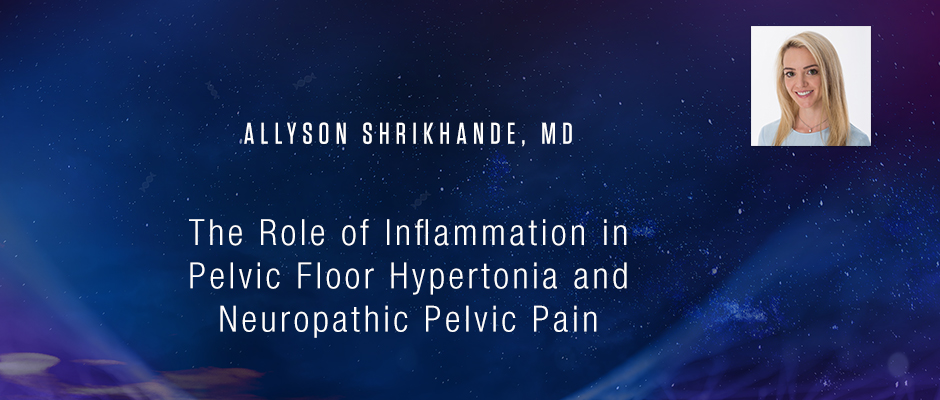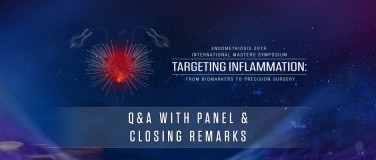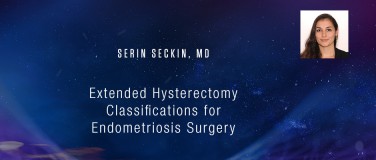Allyson Shrikhande, MD - The Role of Inflammation in Pelvic Floor Hypertonia and Neuropathic Pelvic Pain
Endometriosis Foundation of America
Medical Conference 2019
Targeting Inflammation:
From Biomarkers to Precision Surgery
March 8-9, 2019 - Lenox Hill Hospital, NYC
https://www.endofound.org/medicalconference/2019
... Hi, thank you Doctor Seckin, and Doctor Goldstein, and Doctor Lou, and the EFA for having me today. It is an honor to be here. Okay, so how do ... just need ...
There you go, like that.
Yep. Okay.
Okay, no disclosures. Objectives today, physiatrist approach to the endometriosis, talk a bit about neurogenic inflammation, and mainly about some regenerative medicine techniques from the physiatry approach.
So how does physiatrist approach pelvic pain? We treat the muscles, nerves and joints of the pelvis. We look at ourselves as liaisons between the orthopedic and neurology world, and the gynecological world.
Symptoms we see ... We treat lower abdominal pain, urinary urgency/frequency, pain with intercourse, and pain with either bowel movement, or constipation ...
This is how we're measuring our progress as physiatrists, it's all about return to function. So the data I'll be presenting later is something called the Functional Pelvic Pain Scale, came out of Calgary, and it's about bowel, bladder, intercourse, exercise and ability to work, and sit.
This is the anatomy, and the world that we work on. We're treating ... most of our patients with endometriosis have a concomitant and hypertonic pelvic floor, as well as neurogenic inflammations, who are evaluating the pudendal nerve and its branches, as well as the posterior femoral cutaneous nerve, and the sciatic, as well as the ileum, inguinal and genitofemoral.
This is showing the actin-myosin. Essentially with the hypertonic pelvic floor there's a loss of the H-zone, and we'll talk more about what that means later.
This is the cycle that we see and treat. Essentially with this hypertonic pelvic floor, patients are in this chronic guarding state, secondary to the pro-inflammatory state of endometriosis, as well as pain. With this there comes a local decrease in blood flow, and essentially a change in the pH, which stimulates the inflammatory cascade. This inflammatory cascade leads to peripheral sensitization, and eventually central sensitization.
This is the pro-inflammatory [inaudible 00:02:51] that we treat. Essentially trying to down regulate the massive release of histamine, bradykinin, ex cetera.
The pathophysiology of chronic pelvic pain, essentially experiencing pain for a long period of time, there are changes in the way the spinal cord and brain receive pain, and this leads to an amplification of pain. This is being shown in multiple studies now with chronic pelvic pain. Suzy Asani has a large one, as well as the MAP study. The Multidisciplinary Approach to Pelvic Pain, where Jason Kutch's lab out at USC is really looking at the functional MRI changes in the brain associated with treating patients ... Central sensitization pre and post, particularly the SMA territory of the brain.
This describes these chronic MRNA changes when you have this neurogenic inflammation and allodynic symptoms.
This describes the complex interplay of pain in patients with endometriosis. The inflammatory process and nociceptive pain, and the neuropathic pain. It really is a beautiful picture describing the complexity and addressing every aspect including the endocrine system, and the HPA access.
The treatment algorithm for chronic pelvic pain when patients come to see us, what we do is if they haven't had a proper excision surgery for the endometriosis we'll guide them to that, and treat them either pre or post op, depending on the situation. In addition, we start with pelvic floor physical therapy, and then there's a protocol, an IRB approved protocol that I created, that essentially is external ultrasound guided trigger points and hydrodissection peripheral nerve blocks.
The pathophysiology of it is treating the apparent firing of these sodium/potassium channels, and desensitizing these hyperactive nerves. The hydrodissection technique allows for lysis of the connective tissue bands around these peripheral nerves, essentially creating space for increased blood flow, and allowing the nerves to really heal themselves. In addition we're treating the neurogenic inflammation but trying to deplete substance P histamine and other pro-inflammatory neuro peptides.
These are just some pictures of how we do it, external ultrasound guided with the needle tip going in.
This is what I was asked to talk about. In the world of regenerative medicine, essentially we have two crates. One is for pro-inflammatory, and that is something that's more commonly known. It's called PRP, or platelet rich plasma, so that will stimulate inflammation in hopes of promoting healing. The alpha-2 macroglobulin that we use is in the other realm of anti-inflammatory. We like to explain it to patients as, "It's more soothing.". So, the alpha-2 macroglobulin essentially is the largest non-immunoglobulin protein in the plasma. It is a protease inhibitor. So it's inactivating a large variety of proteinases, it inhibits fibrinolysis, inhibits coagulation, and it's used for chronic pain because it decreases inflammation. Essentially it's a carrier protein, so it binds to growth factors and pro-inflammatory cytokines, and it takes them out of your body. Similar to how a PAC-man pines and removes them out of your body.
Minimal data, most of it is in rats. In China they're looking at using alpha-2 macroglobulin as a radio-protective agent, and essentially showing how the alpha-2 will bind to these pro-inflammatory cytokines, and reduce oxidative stress. In addition in rats, they're looking at using A2M as a chondroprotective agent for osteoarthritis. Essentially they showed that, inducing arthritis in these rats, and then doing an intraarticular injection of the A2M, showed a decrease in the arthritis postoperatively.
The data that we have, we did a retrospective study analyzing the effectiveness of A2M. There were 11 patients, seven patients were male, and four of them had endometriosis, ages 31 to 59. Additional diagnosis other than endo, six had [Interstitial 00:07:46] cystitis as well. We evaluated their visual analog scale, as well as their functional pelvic pain scale pre and post treatments. All patients that in this study ... All 11 patients had complemented an endometriosis excision surgery, as well as multiple courses of pelvic floor physical therapy. Over 60% of the patients have tried RFA, ganglion, impar block, as well as a hypogastric block. So the RFA was of the pudendal nerve. These are clearly our most challenging cases, and they were at the point where they were debating either sacral neuromodulation, a pudendal nerve surgical release, or regenerative technique.
The way it worked, 90ml of the patients blood was drawn and centrifuged down, and the A2M concentrate, it requires 8 to 10 milliliters, was placed externally ultrasound guided. We placed it at the muscles of the [ischiococcygeus 00:08:48], as well as the pudendal nerve and it's selective branches based on the patients symptoms and pain distribution.
The pre and post functional pelvic pain scale went from 13.5 down to 5.6, and the pre and post VAS scale, went from 5.8 down to 3.6. Interestingly enough, the significant improvement was shown in bowel, so pain with bowel movement, pain with intercourse, ability to walk, sleep, and prolonged sitting as well as lifting.
This study has promising results in regards to the use of alpha-2 macroglobulin as a non-opiod treatment to chronic pelvic pain, and provides the foundation for further research, which would involve larger sample sizes, and longer follow up.
Okay, health lifestyle is something that we see ... And treat a lot and discuss with our patients. I know we're on a crunch for time, so I just wanna leave you with this. When looking at a patient I think this one of the most important slides. Really just looking at the complexity, multi-modal approach to these patients, I think is the key.
Thank you.










